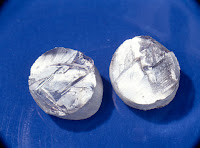 |
| Metallic Sodium |
The lake was Lake Lenore which is just off Highway 17 south of Grand Coulee and north of the town of Soap Lake.
Watch the video, it's interesting.
When the sodium hits the water, it reacts violently as the metal gives up an electron easily (it has only one in its outer valence) to the water (which is normally not a very reactive substance).
The sodium and water reaction makes sodium hydroxide and hydrogen gas. Because the reaction is very exothermic, the hydrogen gas can ignite to react with the oxygen in the air to make more water. Here is the balanced formula of the sodium reaction (I can't do subscripts):
2Na(s) + 2H2O → 2NaOH(aq) + H2(g)
The (s) means "solid," the (aq) means "aqueous," and the (g) means "gas."
The hydrogen plus oxygen reaction looks like this:
2H2(g) + O2(g) → 2H2O
Interestingly, chlorine has only seven electrons in its outer valence. It wants eight to be stable. This is why chlorine is very reactive, too. When you combine it with sodium, it gains an electron from the sodium and they are both stable. This makes sodium chloride or table salt.
These days, Lake Lenore is stocked with fish and is a popular recreational spot.
What do you think of the Army's method of disposal of metallic sodium. Let me know in the comments below.

So are those elements still in the water. Are they dangerous? Or do they evaporate?
ReplyDeleteThe lake isn't dangerous now. Fish live in it.
DeleteIs that lake salt now?
ReplyDelete